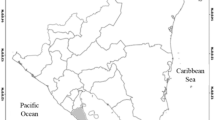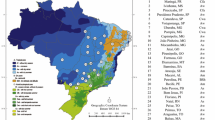Abstract
Reported benefits of green cane trash blanket (GCTB) on the production of sugarcane include soil water retention, supplement nutrients, regulating temperature, and carbon accumulation in the soil. However, it is still uncertain the extent to which the irrigated sugarcane growth is influenced by GCTB. Thus, this study was aimed to analyze a four-year (from 2013 to 2016) irrigated field experiments by a center pivot system in Brazil to evaluate the effect of the transition from burnt-to-GCTB in terms of evapotranspiration, detailed crop development, growth measurements, and soil temperature changes. The experiment consisted of two treatments (bare soil and GCTB) with detailed soil moisture measured by frequency domain reflectometry (FDR), evapotranspiration measured at field level by Bowen ratio method, and evaluations of crop growth and development over the growing seasons. The result showed that the GCTB did not affect crop growth and development except for a few measurement dates in one season which experienced a severe regional drought. In the other growing seasons, however, the study did not show difference in crop evapotranspiration, soil moisture, and crop growth variables. However, the GCTB reduced the soil temperature and its variability as compared to the bare soil treatment in all four depths monitored during the study, which resulted in an average decrease by 4.9 °C in the GCTB treatment in the 0–0.40 m depth profile. Although the GCTB treatment did not increase the yield and ETc, the GTCB in second ratoon (dry year) showed more stalk.m−2 than bare soil probably due to the lower temperature caused by the sugarcane residue on the soil surface.







Similar content being viewed by others
References
Allen, R.G., L.S. Pereira, D. Raes, and M. Smith. 1998. Crop evapotranspiration-guidelines for computing crop water requirements-FAO irrigation and drainage paper 56. Rome: FAO.
Aquino, G.S., C.C. Medina, A.L.P. Junior, L.O. Santos, A.C.B. Cunha, D.A.O. Kussaba, J.H. Santos Júnior, L.F. Almeida, and A.D. Santiago. 2015. Sistema radicular e produtividade de soqueiras de cana-de-açúcar sob diferentes quantidades de palhada. Pesquisa Agropecuaria 79 (6): e20200309. https://doi.org/10.1590/S0100-204X2015001200004.
Azania, A.A.P.M., C.A.M. Azania, R. Gravena, M.C.M.D. Pavani, and R.A. Pitelli. 2002. Interferência da palha de cana- de-açúcar na emergência de espécies de plantas daninhas da família convolvulaceae. Planta Daninha 20: 207–212. https://doi.org/10.1590/S0100-83582002000200006.
Camargo, O.A., A.C. Moniz, J.A. Jorge, and J.M.A. Valadares. 2009. Chemical Analysis Methods, Mineralogical and Physical Soil of the Agronomic Institute of Campinas. Campinas: IAC.
Campos, L.H.F.D., S.J.P.D. Carvalho, P.J. Christoffoleti, C. Fortes, and J.S.D. Silva. 2010. Straw management systems influence biomass accumulation and yield of sugarcane crop (var. RB855453). Acta Scientiarum Agronomy 32: 345–350.
Cerri, C.C., M.V. Galdos, S.M.F. Maia, M. Bernoux, B.J. Feigl, D. Powlson, and C.E.P. Cerri. 2011. Effect of sugarcane harvesting systems on soil carbon stocks in Brazil: An examination of existing data. European Journal of Soil Science 62: 23–28.
CONAB. 2022. Brazilian harvest forecast for sugarcane, season 2022/2023, 2nd survey. Accessed 13 November 2022.
De Beer, A.G., C. Hudson, E. Meyer, and B. Seigmund. 1995. Green cane harvesting and trash management. Proc Int Soc Sug Cane Technol 22: 133–141.
Denmead, O.T., C.L. Mayocchi, and F.X. Dunin. 1997. Does green cane harvesting conserve soil water? Proc. Conf. Aus. Soc. Sugar Technol 19: 139–146.
FAO. 2019. Sugar. In OECD-FAO Agricultural Outlook 2019–2028. Rome: OECD/FAO.
Fortes, C., P.C.O. Trivelin, D.A. Ferreira, A.C. Vitti, H.C.J. Franco, and R. Otto. 2011. Recovery of nitrogen (15N) by sugarcane from previous crop residues and urea fertilisation under a minimum tillage system. Sugar Tech 13: 42–46. https://doi.org/10.1007/s12355-011-0074-4.
Fortes, C., A.C. Vitti, R. Otto, D.A. Ferreira, H.C.J. Franco, and P.C.O. Trivelin. 2013. Contribution of nitrogen from sugarcane harvest residues and urea for crop nutrition. Scientia Agricola 70 (5): 313–320. https://doi.org/10.1590/S0103-90162013000500005.
Galdos, M.V., C.C. Cerri, and C.E.P. Cerri. 2009. Soil carbon stocks under burned and unburned sugarcane in Brazil. Geoderma 153: 347–352. https://doi.org/10.1016/j.geoderma.2009.08.025.
Gava, G.J.C., P.C.O. Trivelin, M.W. Oliveira, and C.P. Penatti. 2001. Growth and accumulation of nitrogen by sugarcane cultivated in soil covered with cane trash. Pesquisa Agropecuária Brasileira 36: 1347–1354. https://doi.org/10.1590/S0100-204X2001001100004.
Goldemberg, J., F.F.C. Mello, C.E.P. Cerri, C.A. Davies, and C.C. Cerri. 2014. Meeting the global demand for biofuels in 2021 through sustainable land use change policy. Energy Policy 69: 14–18. https://doi.org/10.1016/j.enpol.2014.02.008.
Gonçalves, I.Z., E.A.A. Barbosa, L.N.S. Santos, A.A. Nazario, D.R.C. Feitosa, N.F. Tuta, and E.E. Matsura. 2017. Water relations and productivity of sugarcane irrigated with domestic wastewater by subsurface drip. Agricultural Water Management. Elsevier 185 (C): 105–115. https://doi.org/10.1016/j.agwat.2017.01.014.
Gonçalves, A.O., E.H.F.M. Silva, L.G. Gasparotto, J.R. Mantelatto, S. Carmo, I.M. Fattori Júnior, and F.R. Marin. 2020. Improving indirect measurements of the leaf area index using canopy height. Pesquisa Agropecuaria Brasileira 55: 1–9. https://doi.org/10.1590/S1678-3921.pab2020.v55.01894.
Gonçalves, I.Z., L.G. Costa, and F.R. Marin. 2022. Simulating sugarcane yield response to ETc replacements and green cane trash blanket maintenance in Brazil. Rev. Bras. Eng. Agríc. Ambient. 26 (8): 586–593. https://doi.org/10.1590/1807-1929/agriambi.v26n8p586-593.
Graham, M.H., R.J. Haynes, and J.H. Meyer. 2002. Soil organic matter content and quality: Effects of fertilizer applications, burning and trash retention on a long-term sugarcane experiment in South Africa. Soil Biology and Biochemistry 34 (1): 93–102. https://doi.org/10.1016/S0038-0717(01)00160-2.
Hoshino, A.T., F.T. Hata, G.S. de Aquino, A.O. Menezes, M.U. Ventura, and C. Medina. 2017. Mulching with sugarcane straw reduces weed density in sugarcane field. International Journal of Agriculture and Biology 19(1): 121–124. https://doi.org/10.17957/IJAB/15.0252
Leal, M.R.L.V., M.V. Galdos, F.V. Scarpare, J.E.A. Seabra, A. Walter, and C.O.F. Oliveira. 2013. Sugarcane straw availability, quality, recovery and energy use: A literature review. Biomass and Bioenergy 53: 11–19.
Lisboa, I.P., M.R. Cherubin, R.P. Lima, C.C. Cerri, L.S. Satiro, B.J. Wienhold, M.R. Schmer, V.L. Jin, and C.E.P. Cerri. 2018. Sugarcane straw removal effects on plant growth and stalk yield. Industrial Crops and Products 111: 794–806. https://doi.org/10.1016/j.indcrop.2017.11.049.
Marin, F.R., G. Inman-Bamber, T.G. Silva, M.S. Vianna, D.S. Nassif, and K.S. Carvalho. 2020. Sugarcane evapotranspiration and irrigation requirements in tropical climates. Theoretical and Applied Climatology 140: 1349–1357. https://doi.org/10.1007/s00704-020-03161-z.
Marin, F.R., J.I. Rattalino Edreira, J. Andrade, and P. Grassini. 2019. On-farm sugarcane yield and yield components as influenced by number of harvests. Filed Crops Research 240: 134–142. https://doi.org/10.1016/j.fcr.2019.06.011.
Marin, F.R., R.V. Ribeiro, and P.E.R. Marchiori. 2014. How can crop modeling and plant physiology help to understand the plant responses to climate change? A case study with sugarcane. Theoretical and Experimental Plant Physiology 26: 49–63. https://doi.org/10.1007/s40626-014-0006-2.
Menandro, L.M.S., H. Cantarella, H.C.J. Franco, O.T. Kölln, M.T.B. Pimenta, G.M. Sanches, and J.L.N. Carvalho. 2017. Comprehensive assessment of sugarcane straw: implications for biomass and bioenergy production. Biofuels, Bioproducts and Biorefining 11 (3): 488–504. https://doi.org/10.1002/bbb.1760.
Nassif, D.S.P., F.R. Marin, and L.G. Costa. 2013. Padrões mínimos para coleta de dados experimentais para estudos sobre crescimento e desenvolvimento da cultura da cana-de-açúcar. Campinas: Embrapa.
Nassif, D.S.P., F.R. Marin, and L.G. Costa. 2014. Evapotranspiration and transpiration coupling to the atmosphere of sugarcane in Southern Brazil: Scaling up from leaf to field. Sugar Tech 16 (3): 250–254. https://doi.org/10.1007/s12355-013-0267-0.
Ng Cheong, L.R., and M. Teeluck. 2016. The practice of green cane trash blanketing in the irrigated zone of mauritius: effects on soil moisture and water use efficiency of sugarcane. Sugar Tech 18: 124–133. https://doi.org/10.1007/s12355-015-0374-1.
Oliveira, A.P.P., P.J. Thorburn, J.S. Biggs, E. Lima, L.H.C. Dos Anjos, M. Pereira, and N. Zanotti. 2016. The response of sugarcane to trash retention and nitrogen in the Brazilian coastal tablelands: a simulation study. Experimental Agriculture. https://doi.org/10.1017/S0014479714000568.
Olivier, F., and A. Singels. 2012. The effect of crop residue layers on evapotranspiration, growth and yield of irrigated sugarcane. Water SA. https://doi.org/10.4314/wsa.v38i1.10.
Olivier, F.C., and A. Singels. 2015. Increasing water use efficiency of irrigated sugarcane production in South Africa through better agronomic practices. Field Crops Research 176: 87–98. https://doi.org/10.1016/j.fcr.2015.02.010.
Otto, R., S.A.Q. Castro, E. Mariano, S.G.Q. Castro, H.C.J. Franco, and P.C.O. Trivelin. 2016. Nitrogen use efficiency for sugarcane-biofuel production: What is next? BioEnergy Research 9 (4): 1272–1289. https://doi.org/10.1007/s12155-016-9763-x.
Peel, M.C., B.L. Finlayson, and T.A. Mcmahon. 2007. Updated world map of the Koppen–Geiger climate classification. Hydrology Earth System. Science 11: 1633–1644. https://doi.org/10.5194/hess-11-1633-2007.
Perez, P.J., and F. Castellvi F. M. Ibanez, and J.I. Rosell. 1999. Assessment of reliability of Bowen ratio method for partitioning fluxes. Agricultural and Forest Meteorology 97: 141–150. https://doi.org/10.1016/S0168-1923(99)00080-5.
Ripoli, T.C.C., M.L.C. Ripoli, D.V. Casagrandi, and B.Y. Ide. 2006. Plantio de cana-de-açúcar: estado da arte. Piracicaba: T.C.C. Ripoli.
RIDESA. Censo varietal. 2018. https://www.ridesaufscar.com.br/censo-vartietal. Accessed in 4 March 2021.
Robertson, F.A., and P.J. Thorburn. 2007. Management of sugarcane harvest residues: Consequences for soil carbon and nitrogen. Soil Research 13–23.
Rossetto R., F.L.F. Dias, and A.C. Vitti. 2008. Fertilidade do solo, nutrição e adubação. In Cana-de-açúcar, 1ª ed. 221–238. Campinas-SP: IAC.
Ruiz Corrêa, S.T., L.C. Barbosa, L.M.S. Menandro, F.V. Scarpare, K. Reichardt, L.O. de Moraes, T.A.D. Hernandes, H.C.J. Franco, and J.L.N. Carvalho. 2019. Straw removal effects on soil water dynamics, soil temperature, and sugarcane yield in South-Central Brazil. Bioenergy Res 12: 749–763. https://doi.org/10.1007/s12155-019-09981-w.
Sandhu, H.S., M.P. Singh, R.A. Gilbert, F. Subiros-Ruiz, R.W. Rice, and J.M. Shine. 2017. Harvest management effects on sugarcane growth, yield and nutrient cycling in Florida and Costa Rica. Field Crops Research 214: 253–260. https://doi.org/10.1016/j.fcr.2017.09.002.
Santos H.G., dos, P.K.T. Jacomine L.H.C. Anjos V.A. Oliveira, J.F. Lumbreras M.R. Coelho J.A. Almeida A. J.C. Filho, J.B. Oliveira and T.J.F. Cunha. 2018. Brazilian soil classification system . Brasília: Embrapa Soils.
Souza, C.A.A., T.G.F. Silva, L.S.B. Souza, M.S.B. Moura, P.P. Silva, and F.R. Marin. 2020. Straw management effects on sugarcane growth, nutrient cycling and water use in the Brazilian semiarid region. Bragantia 79 (4): 400–411. https://doi.org/10.1590/1678-4499.20200227.
Thorburn, P.J., E.A. Meier, and M.E. Probert. 2005. Modelling nitrogen dynamics in sugarcane systems: Recent advances and applications. Field Crops Research 92 (2–3): 337–351. https://doi.org/10.1016/j.fcr.2005.01.016.
Thorburn, P.J., M.E. Probert, S. Lisson, A.W. Wood, and B.A. Keating. 1999. Impacts of trash retention on soil nitrogen and water: An example from the Australian sugarcane industry. Proceedings of South African Sugar Technology Association 73: 75–79.
Thorburn, P.J., E.A. Meier, K. Collins, and F.A. Robertson. 2012. Changes in soil carbon sequestration, fractionation and soil fertility in response to sugarcane residue retention are site-specific. Soil and Tillage Research 120: 99–111. https://doi.org/10.1016/j.still.2011.11.009.
Van Antwerpen, R., and J.H. Meyer. 2001. The effects of cane trash on yield and nutrition from the long-term field trial at Mount Edgecombe. Proceedings South African Sugarcane Technologists Association 75: 235–241.
Vianna, M.S., D.S.P. Nassif, K.S. Carvalho, and F.R. Marin. 2020. Modelling the trash blanket effect on sugarcane growth and water use. Computers and Electronics in Agriculture 172: 105361. https://doi.org/10.1016/j.compag.2020.105361.
Vitti, A.C., P.C.O. Trivelin, G.J.C. Gava, C.P. Penatti, I.R. Bologna, C.E. Faroni, and H.C.J. Franco. 2007. Produtividade da cana-de-açúcar relacionada ao nitrogênio residual da adubação e do sistema radicular. Pesquisa Agropecuária Brasileira 2: 249–256. https://doi.org/10.1590/S0100-204X2007000200014.
Walter, A., M.V. Galdos, F.V. Scarpare, M.R.L.V. Leal, J.E.A. Seabra, M.P. Cunha, and C.O.F. Oliveira. 2014. Brazilian sugarcane ethanol: developments so far and challenges for the future: Brazilian sugarcane ethanol. Wiley Interdisciplinary Reviews. Energy and Environment 12: 70–92. https://doi.org/10.1002/wene.87.
Wood, A.W. 1991. Management of crop residues following green harvesting of sugarcane in north Queensland. Soil and Tillage Research 20 (1): 69–85. https://doi.org/10.1016/0167-1987(91)90126-I.
Acknowledgements
The Brazilian Research Council (CNPq) and, the Research Foundation of the State of São Paulo (FAPESP).
Funding
This study was supported by the Brazilian Research Council (CNPq grants 425174/2018-2 and 300916/2018-3) and, the Research Foundation of the State of São Paulo (FAPESP Grants 2020/08365-1, 2017/20925-0, 2011/18072-2, 2014/05887-6, 2014/12406-4, 2021/00720-0, 2020/08365-1).
Author information
Authors and Affiliations
Corresponding author
Ethics declarations
Conflict of interest
The authors declare that they have no conflict of interest.
Additional information
Publisher's Note
Springer Nature remains neutral with regard to jurisdictional claims in published maps and institutional affiliations.
Rights and permissions
About this article
Cite this article
Gonçalves, I.Z., Vianna, M.S., Nassif, D.S.P. et al. Effects of Residue from Harvested Green Cane on Evapotranspiration, Growth, and Development of Irrigated Sugarcane in Southern Brazil. Sugar Tech 25, 1445–1455 (2023). https://doi.org/10.1007/s12355-023-01308-6
Received:
Accepted:
Published:
Issue Date:
DOI: https://doi.org/10.1007/s12355-023-01308-6




